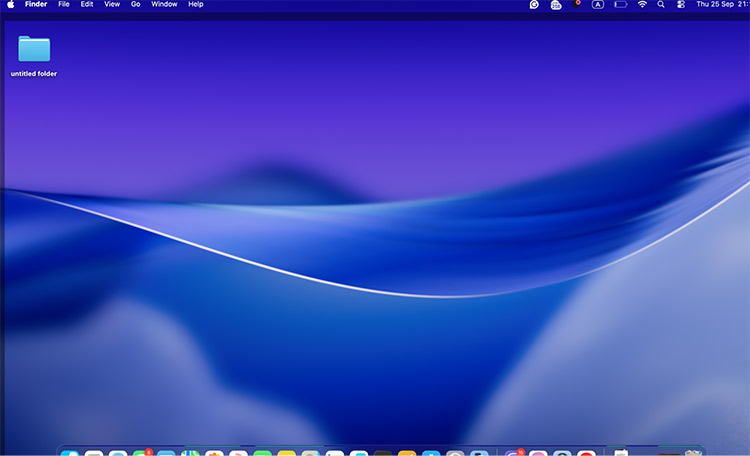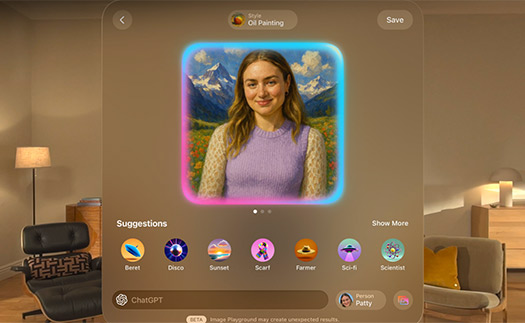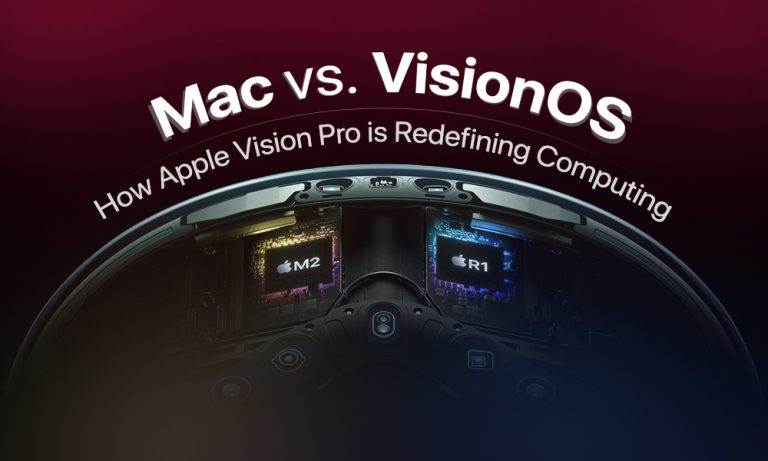Apple revolutionized personal computer capabilities when it launched the Mac in 1984. Decades later, the Vision Pro is poised to do something similar. With macOS 26 Tahoe and visionOS 26, Apple is weaving together the familiar productivity of the desktop with the limitless canvas of spatial computing.
This convergence raises a bigger question: what does “a computer” even mean when your desktop can be a physical monitor one moment and an entire room the next? For tech-savvy users and futurists alike, the Mac vs. VisionOS debate isn’t about replacement – it’s about how Apple is blurring boundaries to reshape the very idea of personal computing.
The Mac: Foundation of Apple’s Productivity Ecosystem
The future direction of VisionOS by Apple depends on the elements that have maintained the Mac as a significant product since 1984.
A Brief Legacy of Reinvention
- The Macintosh computer brought graphical user interfaces to regular consumers when it launched in 1984.
- Mac OS X brought the core design elements of contemporary Apple software to the market in 2001.
- Apple Silicon technology, featuring the M1, M2, and M3 processors, brought revolutionary performance and power efficiency to desktops and laptops throughout 2020.
- macOS 26 “Tahoe” introduced the Liquid Glass design across Apple platforms in 2025. This unifies the look and feel of Mac with iPhone, iPad, and Vision Pro.

Why the Mac Still Matters Today
The Mac remains the central device within Apple’s ecosystem.
- Users gain better control over complex operations.
- The Mac stands out as the Apple product with the widest range of creative and development tools.
- The long product lifespan of Macs remains possible because Apple supports its operating systems and upholds consistent hardware quality standards.
- Apple Intelligence, which launched in 2025, brings on-device AI capabilities to macOS through its features for live translation in Messages and FaceTime, and automated Shortcuts and private text and image generation.
The Creative and Professional Edge
Many professionals view their Mac as their primary workspace for creating future projects.
- Designers depend on Macs to achieve precise control when working with Adobe Creative Cloud applications.
- The development of iPhone and iPad applications, as well as Vision Pro applications, occurs through Xcode, which developers use to create these applications.
VisionOS: Apple’s Leap Into Spatial Computing
If the Mac represents the past and present of productivity, VisionOS is Apple’s bold bet on the future.
A New Computing Paradigm
- Spatial workspaces → Apps and windows are no longer confined to a monitor. They float in your physical environment, adjustable in size and placement.
- Boundless displays → A single Vision Pro can turn your living room wall into an infinite ultrawide screen.
- Immersive contexts → Whether reviewing a 3D model or watching a film, VisionOS surrounds you with the content, not just a flat projection of it.
- Persistent spatial content → With visionOS 26, widgets and apps can remain anchored in your room, even after restarting the device, transforming Apple Vision Pro into part of your actual environment.

Natural Interaction, No Peripherals
Unlike the Mac, VisionOS is designed to eliminate traditional input devices:
- Eyes → You look at what you want to select.
- Hands → Subtle pinches, swipes, and gestures let you navigate and manipulate apps.
- Voice → Dictation and commands make the system accessible without a keyboard.
Now, visionOS 26 also supports PlayStation VR2 Sense controllers for high-precision spatial input, and hand tracking has been boosted to 90Hz for smoother, more natural gestures.
Early Use Cases and Adoption
While VisionOS is still in its infancy, Apple is clearly seeding it for both work and play:
- Entertainment. Immersive movies and Apple TV+ experiences that scale far beyond a TV.
- Design & 3D modeling. Perfect for industries where spatial perspective is essential.
- Collaboration. More expressive Personas and shared spatial experiences allow multiple Vision Pro users in the same room to work and watch together.
VisionOS is less about replacing the Mac and more about expanding the very idea of a computer. In short, VisionOS is Apple’s first serious attempt to create a post-screen future – one where digital tools live not on a rectangle in front of you, but all around you.
Where the Lines Blur
For Apple, the Mac and VisionOS aren’t meant to live in separate universes — they are designed to flow into one another. That’s where the magic happens.
Shared DNA
- The design of Liquid Glass now maintains uniformity across macOS, iOS, iPadOS, and visionOS platforms.
- The Safari, Messages, Photos, and Notes applications from Apple operate without interruption between the two platforms.
- Your workflow remains continuous because AirDrop, Handoff, and iCloud enable seamless device-to-device transitions.
Apple Intelligence powers private, on-device AI experiences consistently across Mac, iPhone, iPad, and Apple Vision Pro.
The Mac Inside Vision Pro
- With Mac Virtual Display, your Mac can project its screen into VisionOS as a huge floating monitor.
- This effectively turns Vision Pro into the most flexible external display Apple has ever built.
The Evolution of Input
- Mac: Precision tools – mouse, trackpad, keyboard.
- VisionOS: Natural tools – eyes, hands, voice, plus optional VR controllers.
- Together: Apple is laying the groundwork for a future where input is fluid and interchangeable, depending on context.
Apple’s Strategic Vision
Apple has never been a company that rips away the old. Instead, it builds bridges to the new.
- The Mac stays as the anchor for serious work.
- VisionOS adds a layer of immersion when space, scale, or presence makes sense.
- Apple Vision Pro today is expensive and niche, much like the first Mac.
- Over time, costs will fall, hardware will shrink, and VisionOS will mature.
- Apple’s real play: to gradually redefine “computer” from flat screens to spatial environments, powered by shared design (Liquid Glass) and intelligence (Apple Intelligence).
The Big Picture: Redefining Personal Computing
Apple guides us toward an interactive display-based future.
What It Means for Users
- Creators. Boundless screens for editing, designing, and coding.
- Professionals. Virtual offices with infinite workspace.
- Everyday users. Movies, calls, and apps that surround you, not just sit in front of you.
The fundamental shift is psychological: the computer is no longer a thing you sit in front of. It’s a space you step into.
Conclusion
The Mac and VisionOS aren’t rivals fighting for the future – they are co-conspirators shaping it. The Mac keeps us grounded in precision, stability, and proven workflows. VisionOS opens a door to a computing experience without borders.
The two examples suggest that computers will evolve beyond their current forms, such as desk boxes and laptop bags, to become individual digital spaces that learn from users and expand with them through AI technology, while functioning across various interfaces.


